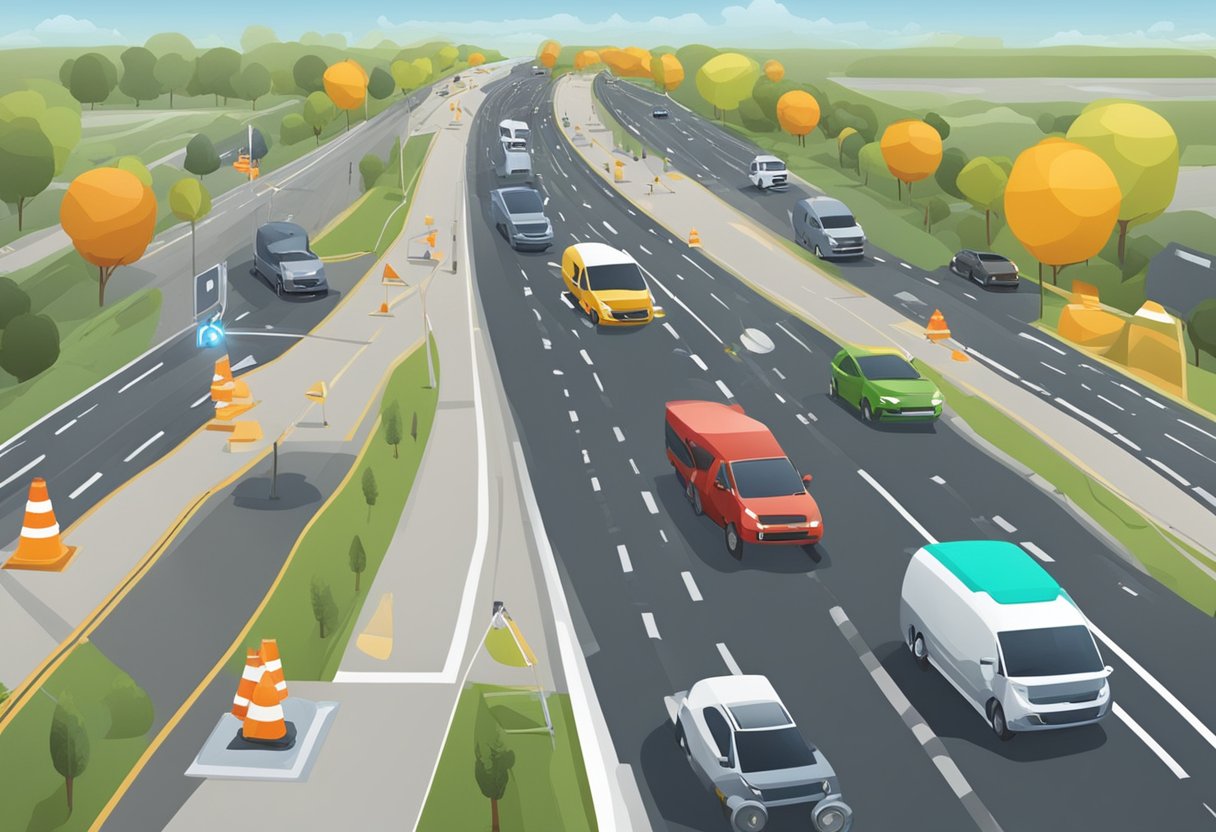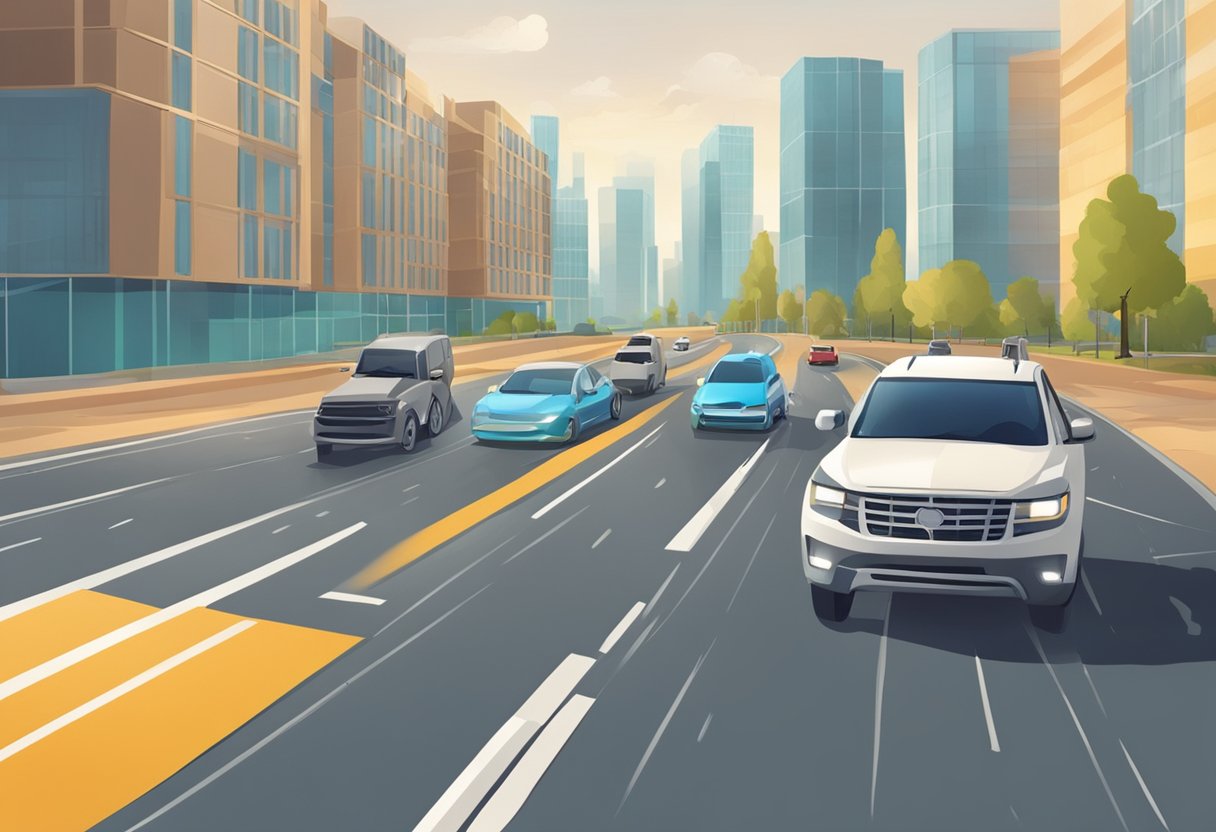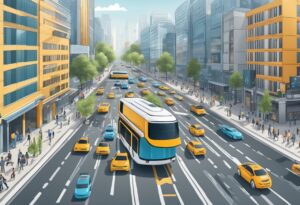Vehicle-to-vehicle (V2V) communication technology is an innovative solution that aims to reduce accidents and enhance road safety.
V2V communication systems allow vehicles on the road to communicate with each other, exchanging information such as speed, heading, and braking status.
This information can be used to alert drivers of potential hazards, such as an approaching vehicle in their blind spot or a sudden stop ahead.
By providing real-time information, V2V communication systems can help drivers make informed decisions, avoid collisions, and ultimately reduce accidents on the road.

Fundamentals of Vehicle-to-Vehicle Communication
V2V communication systems are composed of devices installed in vehicles that use dedicated short-range radio communication (DSRC) to exchange messages containing vehicle information.
V2V devices use this information from other vehicles and determine if a warning to the vehicle’s driver is necessary.
V2V communication technology is being used in connected networks to reduce traffic congestion, improve passenger safety, and enable the efficient management of vehicles on roads.

Understanding V2V Technologies
Vehicle-to-vehicle (V2V) communication is a new technology that allows vehicles on the road to communicate with each other to reduce traffic, accidents, and ensure the safety of people.
This technology enables vehicles to exchange information about their speed, location, and direction of travel.
V2V communication is an essential component of intelligent transportation systems (ITS) that seek to improve transportation safety, efficiency, and sustainability.
The Role of IEEE and ITS in V2V Development
The Institute of Electrical and Electronics Engineers (IEEE) plays a significant role in the development of V2V communication technology.
The IEEE standards committee has developed standards for V2V communication that define the communication protocols, message formats, and data elements used in V2V communication.
These standards enable interoperability between different V2V communication systems.
Intelligent transportation systems (ITS) also play a critical role in the development of V2V communication technology.
ITS is a combination of advanced communication, control, and information technologies that improve transportation safety, efficiency, and sustainability.
V2V communication is an essential component of ITS that enables vehicles to communicate with each other and with the infrastructure.
Communication Protocols: DSRC and C-V2X
V2V communication can use different communication protocols, such as Dedicated Short-Range Communication (DSRC) and Cellular Vehicle-to-Everything (C-V2X).
DSRC is a wireless communication protocol that operates in the 5.9 GHz frequency band. DSRC enables vehicles to communicate with each other and with the infrastructure.
C-V2X, on the other hand, uses the cellular network to enable V2V communication.
C-V2X can operate in both the 4G and 5G networks and can provide a broader range of communication services.
Enhancing Road Safety with V2V
Vehicle-to-vehicle (V2V) communication technology is a promising solution to reduce the number of accidents on highways.
V2V enables vehicles to communicate with one another, sharing information about their speed, position, and direction of travel.
This information can be used to prevent accidents by alerting drivers to potential hazards and providing them with critical information to make informed decisions.
Preventing Accidents on Highways
V2V technology can help prevent accidents on highways by providing drivers with real-time information about the position and speed of other vehicles.
This can be especially useful in situations where visibility is limited, such as during heavy rain or fog.
By alerting drivers to potential hazards, V2V technology can help prevent accidents and save lives.
Reducing Blind Spots and Improving Visibility
Blind spots are a major cause of accidents on highways. V2V technology can help reduce blind spots by providing drivers with information about the position and speed of other vehicles, even if they are not visible.
This can help drivers make safer lane changes and avoid collisions.
In addition to reducing blind spots, V2V technology can also improve visibility by providing drivers with real-time information about road conditions, such as traffic congestion and accidents.
This can help drivers make informed decisions about their route and avoid potential hazards.
V2V Impact on Traffic Congestion and Safety
V2V technology can also have a significant impact on traffic congestion and safety.
By providing drivers with real-time information about traffic conditions, V2V technology can help reduce congestion and improve traffic flow.
This can help reduce the risk of accidents and improve overall road safety.
Challenges and Opportunities in V2V Adoption

Addressing V2V Communication Challenges
While V2V communication technology has the potential to significantly reduce the number of accidents on the road, there are still several challenges that need to be addressed before it can be widely adopted.
One of the main challenges is ensuring that the communication between vehicles is reliable and secure.
This requires the development of robust communication protocols that can handle the high volume of data that needs to be transmitted between vehicles.
Another challenge is ensuring that V2V communication works effectively in all weather conditions.
Heavy rain, snow, and fog can all interfere with the signals transmitted between vehicles, making it difficult for them to communicate effectively.
To address this issue, researchers are working on developing communication systems that can adapt to different weather conditions and ensure that the signals remain strong and reliable.
Opportunities for V2V in Autonomous Vehicles
V2V communication technology has the potential to play a key role in the development of autonomous vehicles.
By enabling vehicles to communicate with each other, it can help to improve safety and reduce the risk of accidents.
For example, if one vehicle detects an obstacle in the road, it can transmit this information to other vehicles in the area, allowing them to adjust their speed and avoid the obstacle.
V2V communication can also help to reduce traffic congestion by enabling vehicles to coordinate with each other and optimize their routes.
This can help to reduce travel times and improve the overall efficiency of the transportation system.
Infrastructure and Regulatory Considerations
To ensure the successful adoption of V2V communication technology, there are several infrastructure and regulatory considerations that need to be taken into account.
For example, the National Highway Traffic Safety Administration (NHTSA) has proposed a rule that would require all new cars to be equipped with V2V communication technology.
This would help to ensure that all vehicles on the road are able to communicate with each other and improve safety.
However, there are also concerns about the cost of implementing V2V communication technology and the need for a robust infrastructure to support it.
This includes the need for a reliable wireless network that can handle the high volume of data transmitted between vehicles.
Future Directions in V2V Communication
Integration with 5G and Beyond
As the world moves towards the deployment of 5G networks, V2V communication is expected to become an integral part of the communication ecosystem.
5G networks will offer higher data rates, lower latency, and increased reliability, which are critical for V2V communication.
The integration of V2V communication with 5G networks will enable V2V communication to be more reliable, faster, and more secure.
V2V in the Context of Intelligent Transportation
V2V communication can be integrated into intelligent transportation systems (ITS) to improve traffic flow and reduce accidents.
ITS relies on the exchange of information between vehicles, infrastructure, and other road users to improve safety and efficiency.
V2V communication can provide real-time information about traffic conditions, road hazards, and weather conditions, which can be used to optimize traffic flow and reduce congestion.
Research and Development in V2V
Research and development in V2V communication is ongoing. It focuses on improving the reliability, security, and efficiency of V2V communication.
One area of research is the development of V2X communication. V2X includes V2V, vehicle-to-infrastructure (V2I), and vehicle-to-pedestrian (V2P) communication. V2X communication will enable vehicles to communicate with other road users, including pedestrians and cyclists, to improve safety and reduce accidents.
Another area of research is the development of technology mixtures. These combine different communication technologies, such as LTE and Wi-Fi, to improve the reliability and efficiency of V2V communication.
The future of V2V communication looks promising. Ongoing research and development focus on improving the reliability, security, and efficiency of V2V communication.
The integration of V2V communication with 5G networks and ITS will enable V2V communication to become an integral part of the communication ecosystem. This will improve traffic flow and reduce accidents.



